Strategy and Change: Singapore Airlines in a Global Environment
VerifiedAdded on 2023/04/20
|26
|5205
|432
Report
AI Summary
This report provides a comprehensive analysis of strategic change at Singapore Airlines, a company founded in 1972 that has grown into a globally recognized airline. It examines the macro and micro environments using PESTLE and Porter's Five Forces models, along with a resource-based view employing the VRIO framework. The analysis covers emerging trends, strategic objectives, and SWOT analysis. The report also delves into the value creation model, detailing primary and secondary activities within Porter's value chain, including human resource management, operations, marketing, and logistics. It discusses the process of strategic change, potential blockages, and facilitators, concluding with an analysis of the product lifecycle stage. The aim is to understand how Singapore Airlines maintains its competitive advantage and adapts to the evolving aviation industry landscape. Desklib is a platform that provides all the necessary AI based study tools for students.
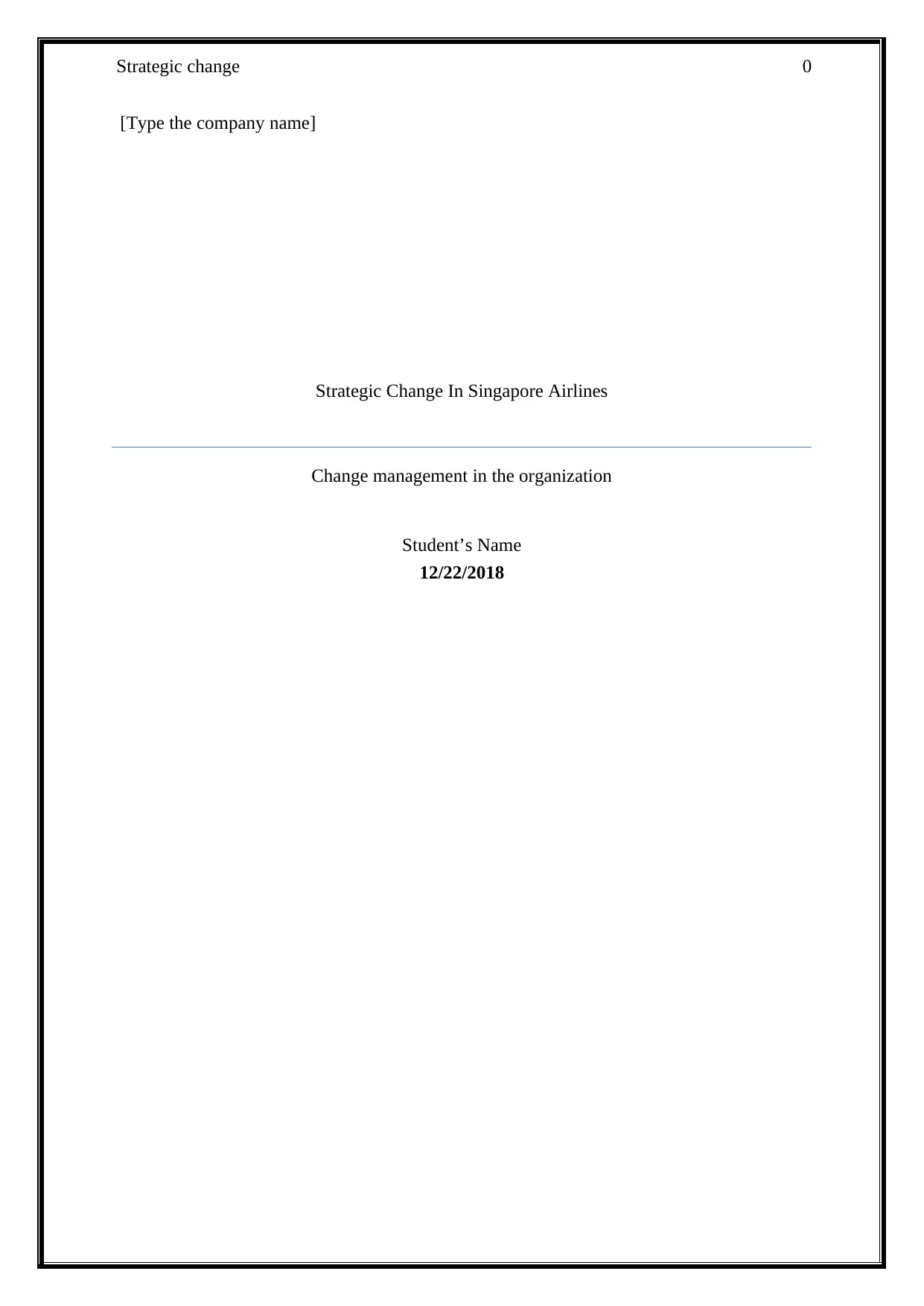
Strategic change 0
[Type the company name]
Strategic Change In Singapore Airlines
Change management in the organization
Student’s Name
12/22/2018
[Type the company name]
Strategic Change In Singapore Airlines
Change management in the organization
Student’s Name
12/22/2018
Paraphrase This Document
Need a fresh take? Get an instant paraphrase of this document with our AI Paraphraser
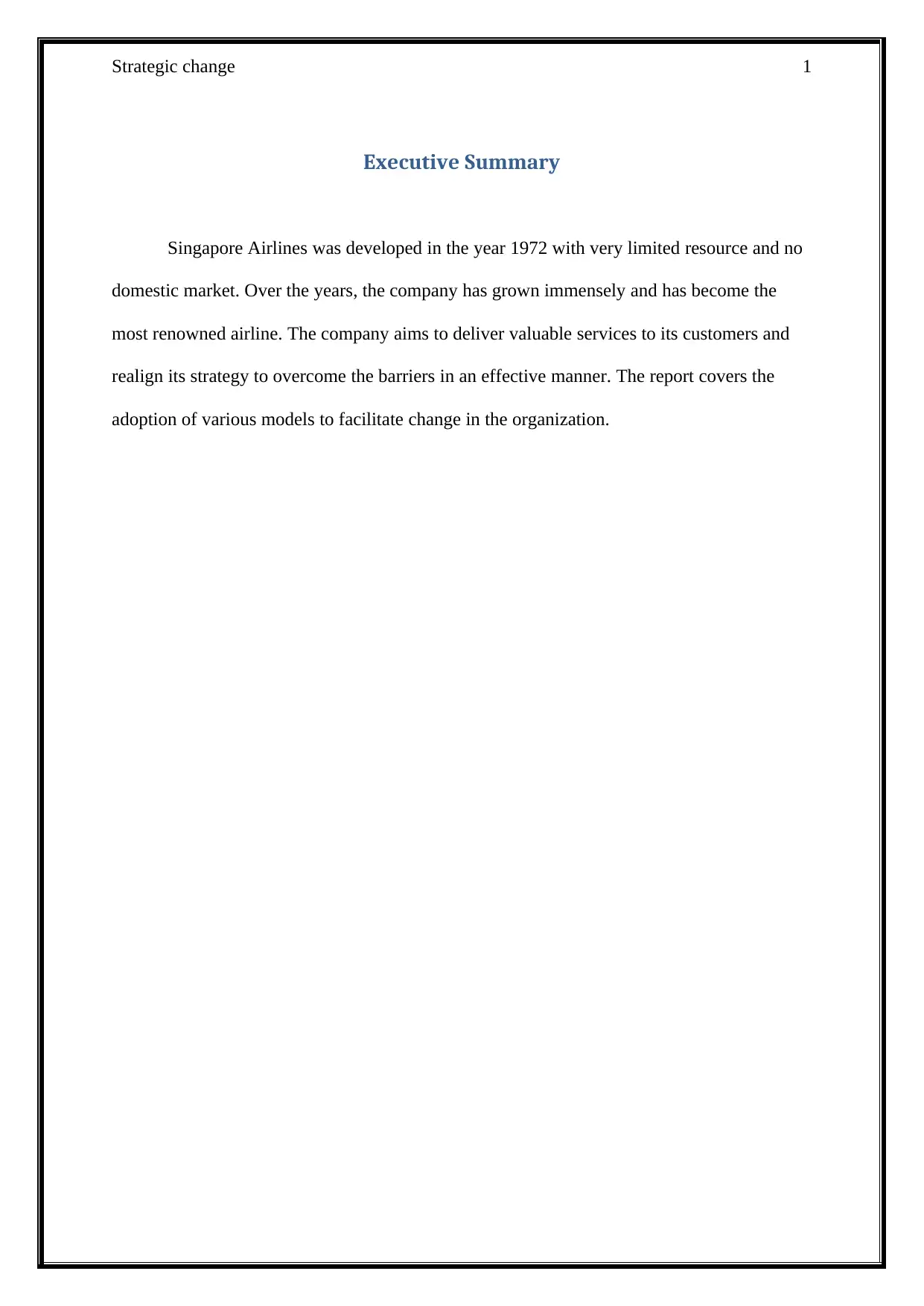
Strategic change 1
Executive Summary
Singapore Airlines was developed in the year 1972 with very limited resource and no
domestic market. Over the years, the company has grown immensely and has become the
most renowned airline. The company aims to deliver valuable services to its customers and
realign its strategy to overcome the barriers in an effective manner. The report covers the
adoption of various models to facilitate change in the organization.
Executive Summary
Singapore Airlines was developed in the year 1972 with very limited resource and no
domestic market. Over the years, the company has grown immensely and has become the
most renowned airline. The company aims to deliver valuable services to its customers and
realign its strategy to overcome the barriers in an effective manner. The report covers the
adoption of various models to facilitate change in the organization.
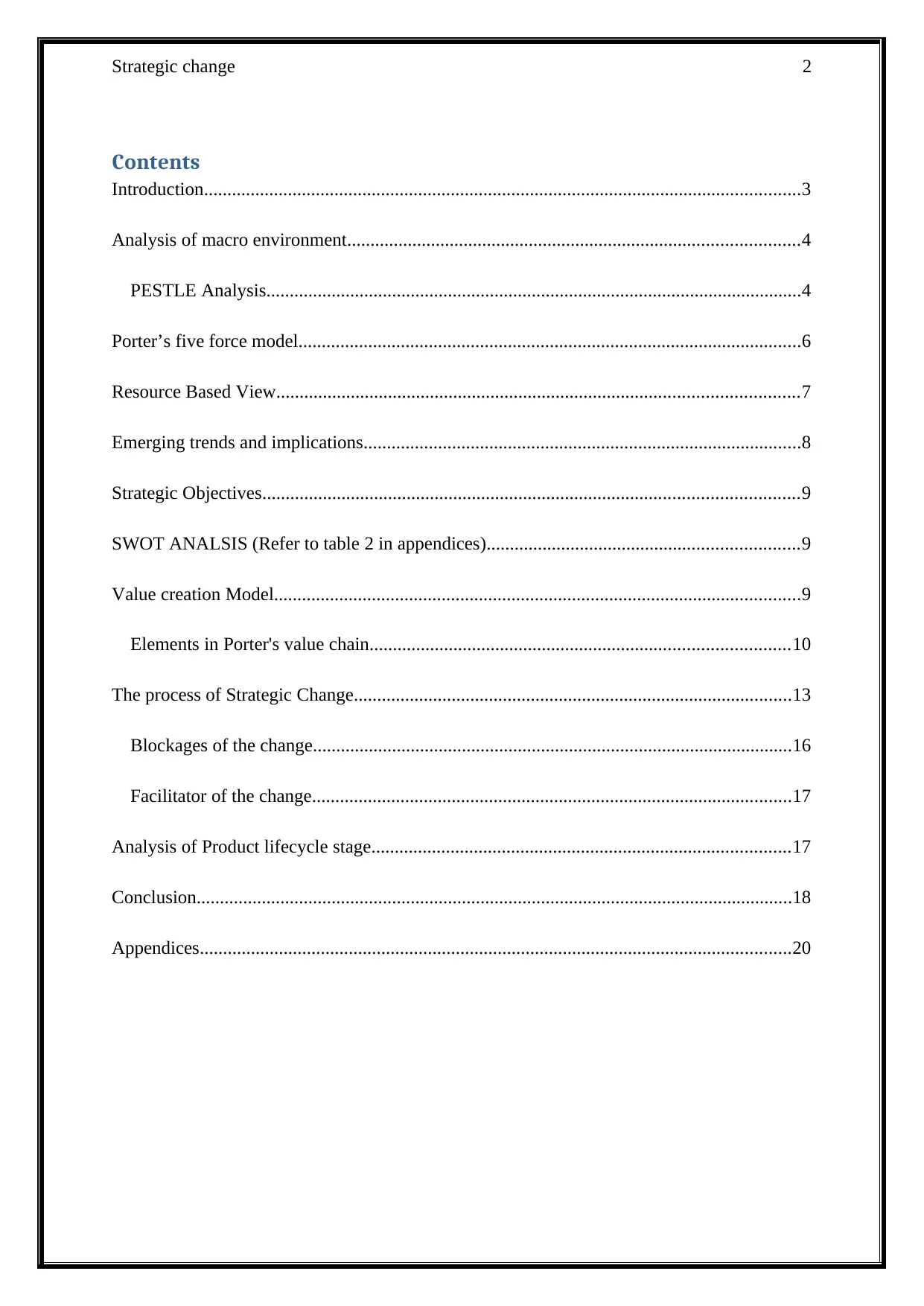
Strategic change 2
Contents
Introduction................................................................................................................................3
Analysis of macro environment.................................................................................................4
PESTLE Analysis...................................................................................................................4
Porter’s five force model............................................................................................................6
Resource Based View................................................................................................................7
Emerging trends and implications..............................................................................................8
Strategic Objectives...................................................................................................................9
SWOT ANALSIS (Refer to table 2 in appendices)...................................................................9
Value creation Model.................................................................................................................9
Elements in Porter's value chain..........................................................................................10
The process of Strategic Change..............................................................................................13
Blockages of the change.......................................................................................................16
Facilitator of the change.......................................................................................................17
Analysis of Product lifecycle stage..........................................................................................17
Conclusion................................................................................................................................18
Appendices...............................................................................................................................20
Contents
Introduction................................................................................................................................3
Analysis of macro environment.................................................................................................4
PESTLE Analysis...................................................................................................................4
Porter’s five force model............................................................................................................6
Resource Based View................................................................................................................7
Emerging trends and implications..............................................................................................8
Strategic Objectives...................................................................................................................9
SWOT ANALSIS (Refer to table 2 in appendices)...................................................................9
Value creation Model.................................................................................................................9
Elements in Porter's value chain..........................................................................................10
The process of Strategic Change..............................................................................................13
Blockages of the change.......................................................................................................16
Facilitator of the change.......................................................................................................17
Analysis of Product lifecycle stage..........................................................................................17
Conclusion................................................................................................................................18
Appendices...............................................................................................................................20
⊘ This is a preview!⊘
Do you want full access?
Subscribe today to unlock all pages.

Trusted by 1+ million students worldwide
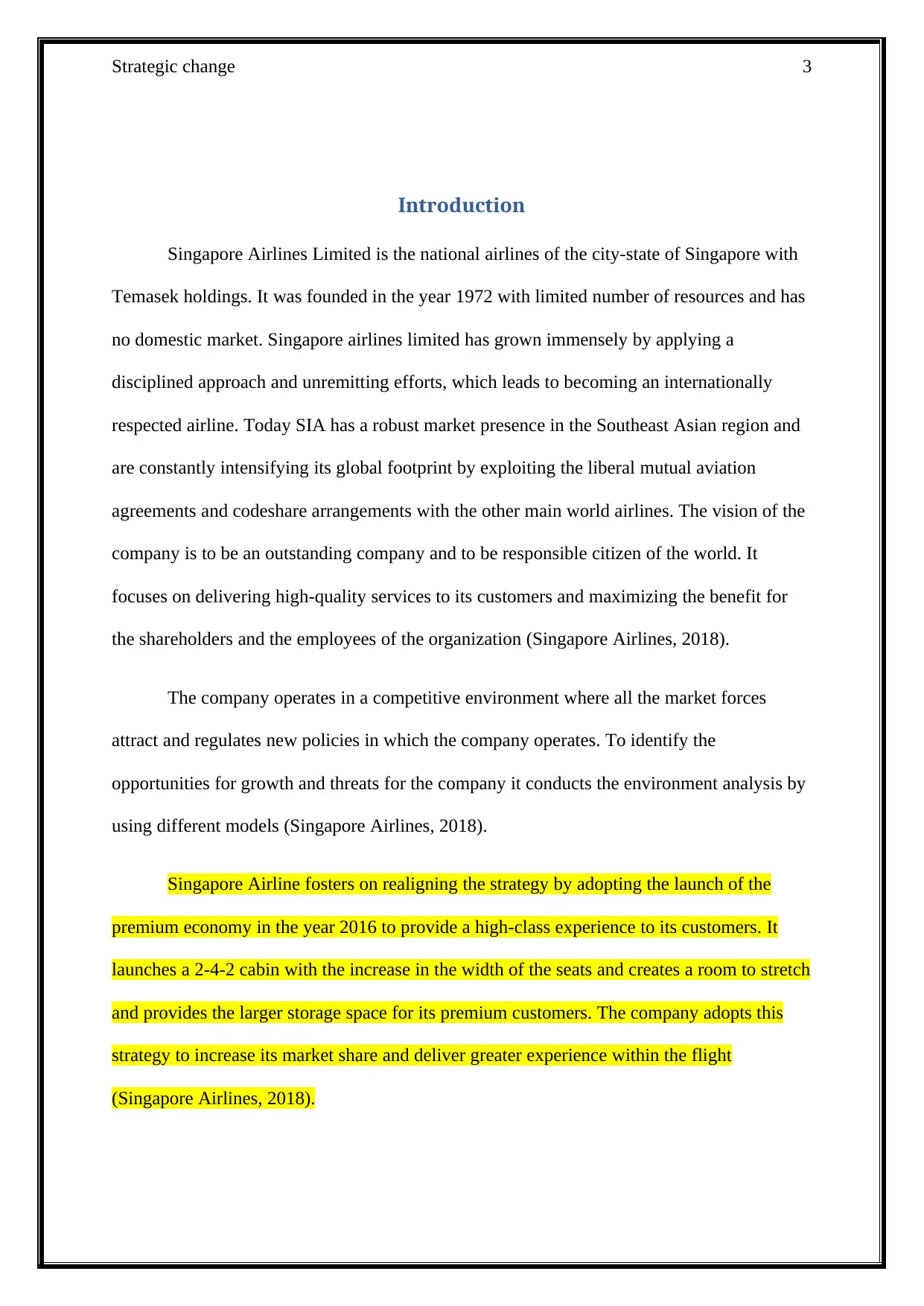
Strategic change 3
Introduction
Singapore Airlines Limited is the national airlines of the city-state of Singapore with
Temasek holdings. It was founded in the year 1972 with limited number of resources and has
no domestic market. Singapore airlines limited has grown immensely by applying a
disciplined approach and unremitting efforts, which leads to becoming an internationally
respected airline. Today SIA has a robust market presence in the Southeast Asian region and
are constantly intensifying its global footprint by exploiting the liberal mutual aviation
agreements and codeshare arrangements with the other main world airlines. The vision of the
company is to be an outstanding company and to be responsible citizen of the world. It
focuses on delivering high-quality services to its customers and maximizing the benefit for
the shareholders and the employees of the organization (Singapore Airlines, 2018).
The company operates in a competitive environment where all the market forces
attract and regulates new policies in which the company operates. To identify the
opportunities for growth and threats for the company it conducts the environment analysis by
using different models (Singapore Airlines, 2018).
Singapore Airline fosters on realigning the strategy by adopting the launch of the
premium economy in the year 2016 to provide a high-class experience to its customers. It
launches a 2-4-2 cabin with the increase in the width of the seats and creates a room to stretch
and provides the larger storage space for its premium customers. The company adopts this
strategy to increase its market share and deliver greater experience within the flight
(Singapore Airlines, 2018).
Introduction
Singapore Airlines Limited is the national airlines of the city-state of Singapore with
Temasek holdings. It was founded in the year 1972 with limited number of resources and has
no domestic market. Singapore airlines limited has grown immensely by applying a
disciplined approach and unremitting efforts, which leads to becoming an internationally
respected airline. Today SIA has a robust market presence in the Southeast Asian region and
are constantly intensifying its global footprint by exploiting the liberal mutual aviation
agreements and codeshare arrangements with the other main world airlines. The vision of the
company is to be an outstanding company and to be responsible citizen of the world. It
focuses on delivering high-quality services to its customers and maximizing the benefit for
the shareholders and the employees of the organization (Singapore Airlines, 2018).
The company operates in a competitive environment where all the market forces
attract and regulates new policies in which the company operates. To identify the
opportunities for growth and threats for the company it conducts the environment analysis by
using different models (Singapore Airlines, 2018).
Singapore Airline fosters on realigning the strategy by adopting the launch of the
premium economy in the year 2016 to provide a high-class experience to its customers. It
launches a 2-4-2 cabin with the increase in the width of the seats and creates a room to stretch
and provides the larger storage space for its premium customers. The company adopts this
strategy to increase its market share and deliver greater experience within the flight
(Singapore Airlines, 2018).
Paraphrase This Document
Need a fresh take? Get an instant paraphrase of this document with our AI Paraphraser
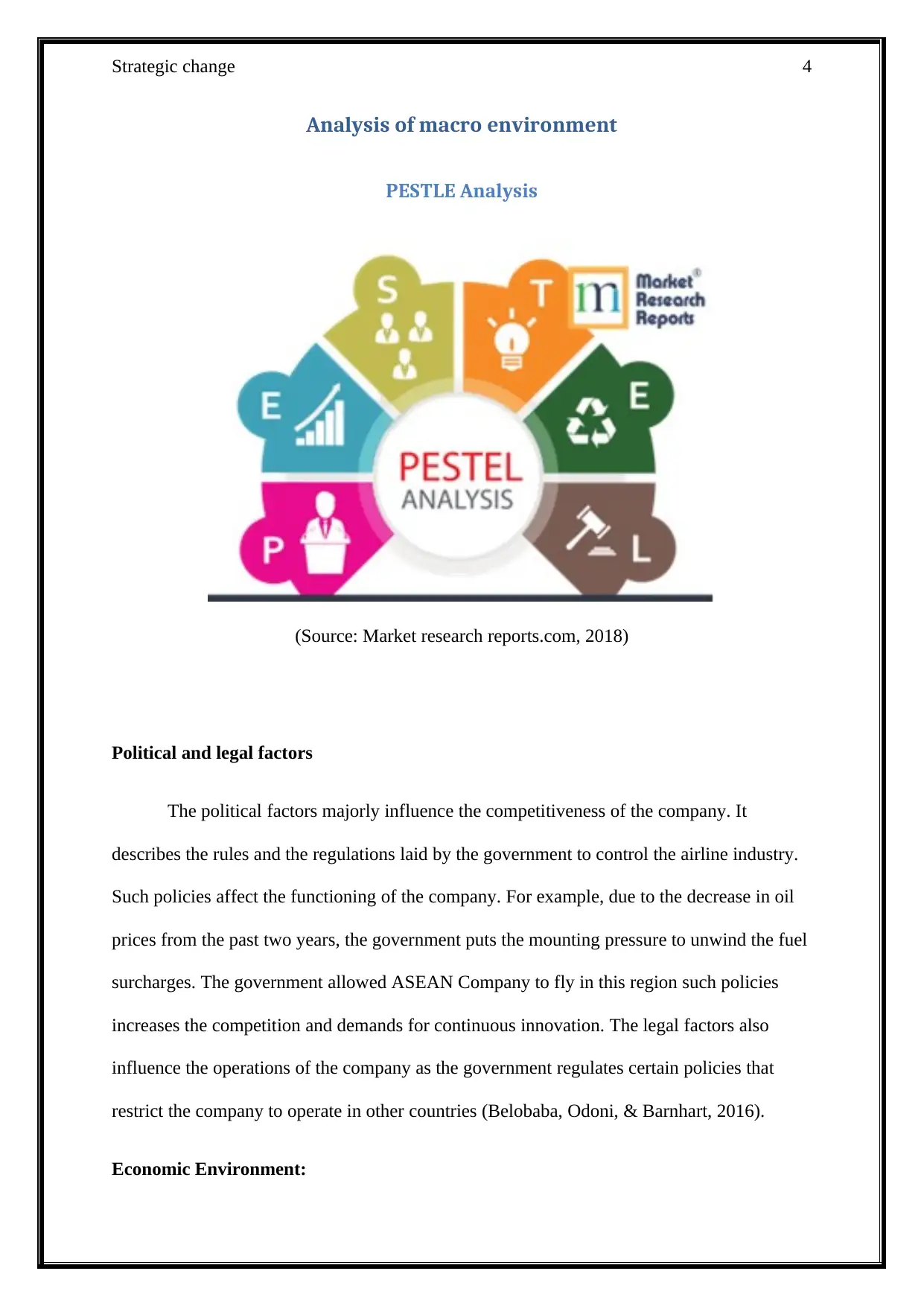
Strategic change 4
Analysis of macro environment
PESTLE Analysis
(Source: Market research reports.com, 2018)
Political and legal factors
The political factors majorly influence the competitiveness of the company. It
describes the rules and the regulations laid by the government to control the airline industry.
Such policies affect the functioning of the company. For example, due to the decrease in oil
prices from the past two years, the government puts the mounting pressure to unwind the fuel
surcharges. The government allowed ASEAN Company to fly in this region such policies
increases the competition and demands for continuous innovation. The legal factors also
influence the operations of the company as the government regulates certain policies that
restrict the company to operate in other countries (Belobaba, Odoni, & Barnhart, 2016).
Economic Environment:
Analysis of macro environment
PESTLE Analysis
(Source: Market research reports.com, 2018)
Political and legal factors
The political factors majorly influence the competitiveness of the company. It
describes the rules and the regulations laid by the government to control the airline industry.
Such policies affect the functioning of the company. For example, due to the decrease in oil
prices from the past two years, the government puts the mounting pressure to unwind the fuel
surcharges. The government allowed ASEAN Company to fly in this region such policies
increases the competition and demands for continuous innovation. The legal factors also
influence the operations of the company as the government regulates certain policies that
restrict the company to operate in other countries (Belobaba, Odoni, & Barnhart, 2016).
Economic Environment:
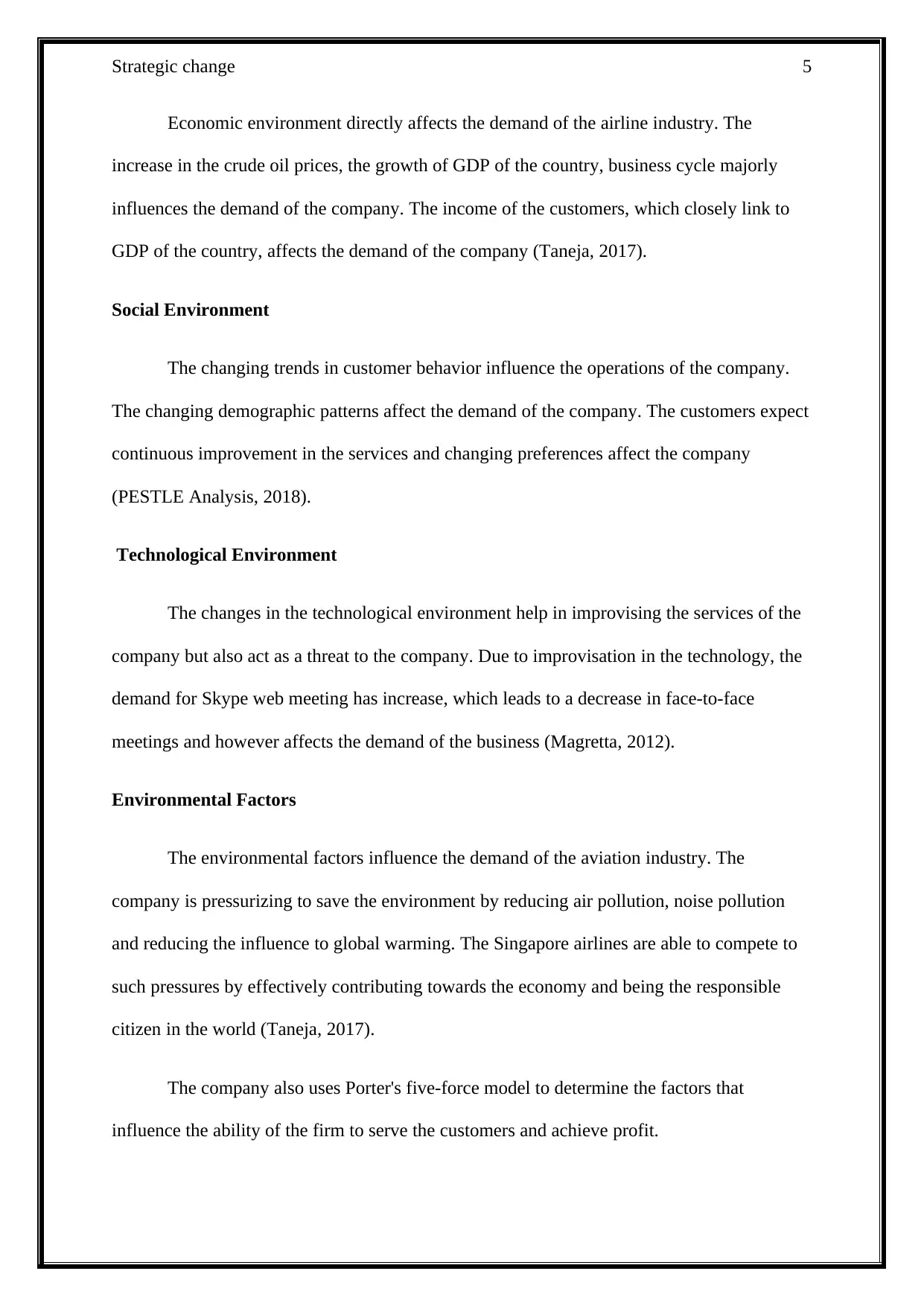
Strategic change 5
Economic environment directly affects the demand of the airline industry. The
increase in the crude oil prices, the growth of GDP of the country, business cycle majorly
influences the demand of the company. The income of the customers, which closely link to
GDP of the country, affects the demand of the company (Taneja, 2017).
Social Environment
The changing trends in customer behavior influence the operations of the company.
The changing demographic patterns affect the demand of the company. The customers expect
continuous improvement in the services and changing preferences affect the company
(PESTLE Analysis, 2018).
Technological Environment
The changes in the technological environment help in improvising the services of the
company but also act as a threat to the company. Due to improvisation in the technology, the
demand for Skype web meeting has increase, which leads to a decrease in face-to-face
meetings and however affects the demand of the business (Magretta, 2012).
Environmental Factors
The environmental factors influence the demand of the aviation industry. The
company is pressurizing to save the environment by reducing air pollution, noise pollution
and reducing the influence to global warming. The Singapore airlines are able to compete to
such pressures by effectively contributing towards the economy and being the responsible
citizen in the world (Taneja, 2017).
The company also uses Porter's five-force model to determine the factors that
influence the ability of the firm to serve the customers and achieve profit.
Economic environment directly affects the demand of the airline industry. The
increase in the crude oil prices, the growth of GDP of the country, business cycle majorly
influences the demand of the company. The income of the customers, which closely link to
GDP of the country, affects the demand of the company (Taneja, 2017).
Social Environment
The changing trends in customer behavior influence the operations of the company.
The changing demographic patterns affect the demand of the company. The customers expect
continuous improvement in the services and changing preferences affect the company
(PESTLE Analysis, 2018).
Technological Environment
The changes in the technological environment help in improvising the services of the
company but also act as a threat to the company. Due to improvisation in the technology, the
demand for Skype web meeting has increase, which leads to a decrease in face-to-face
meetings and however affects the demand of the business (Magretta, 2012).
Environmental Factors
The environmental factors influence the demand of the aviation industry. The
company is pressurizing to save the environment by reducing air pollution, noise pollution
and reducing the influence to global warming. The Singapore airlines are able to compete to
such pressures by effectively contributing towards the economy and being the responsible
citizen in the world (Taneja, 2017).
The company also uses Porter's five-force model to determine the factors that
influence the ability of the firm to serve the customers and achieve profit.
⊘ This is a preview!⊘
Do you want full access?
Subscribe today to unlock all pages.

Trusted by 1+ million students worldwide
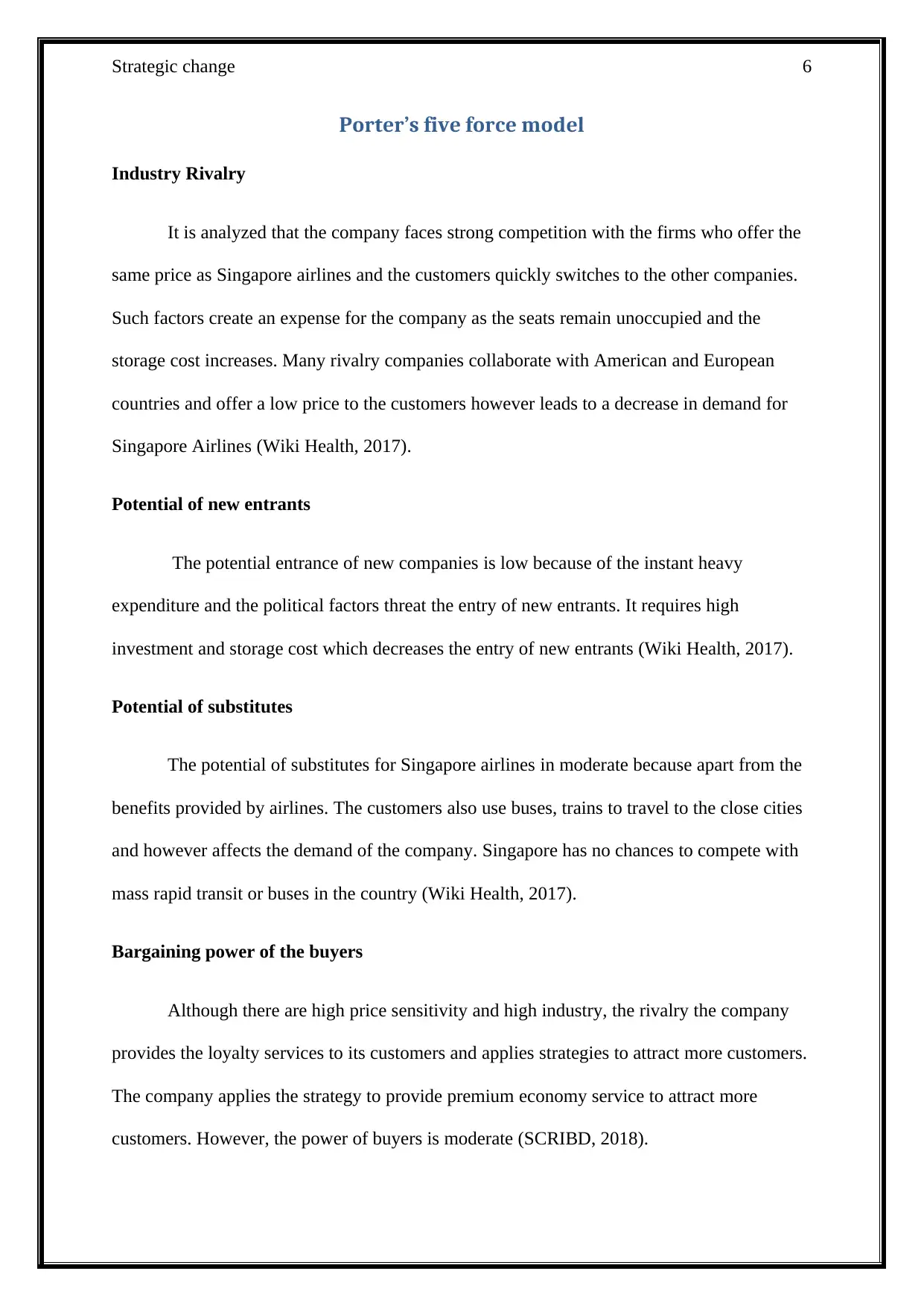
Strategic change 6
Porter’s five force model
Industry Rivalry
It is analyzed that the company faces strong competition with the firms who offer the
same price as Singapore airlines and the customers quickly switches to the other companies.
Such factors create an expense for the company as the seats remain unoccupied and the
storage cost increases. Many rivalry companies collaborate with American and European
countries and offer a low price to the customers however leads to a decrease in demand for
Singapore Airlines (Wiki Health, 2017).
Potential of new entrants
The potential entrance of new companies is low because of the instant heavy
expenditure and the political factors threat the entry of new entrants. It requires high
investment and storage cost which decreases the entry of new entrants (Wiki Health, 2017).
Potential of substitutes
The potential of substitutes for Singapore airlines in moderate because apart from the
benefits provided by airlines. The customers also use buses, trains to travel to the close cities
and however affects the demand of the company. Singapore has no chances to compete with
mass rapid transit or buses in the country (Wiki Health, 2017).
Bargaining power of the buyers
Although there are high price sensitivity and high industry, the rivalry the company
provides the loyalty services to its customers and applies strategies to attract more customers.
The company applies the strategy to provide premium economy service to attract more
customers. However, the power of buyers is moderate (SCRIBD, 2018).
Porter’s five force model
Industry Rivalry
It is analyzed that the company faces strong competition with the firms who offer the
same price as Singapore airlines and the customers quickly switches to the other companies.
Such factors create an expense for the company as the seats remain unoccupied and the
storage cost increases. Many rivalry companies collaborate with American and European
countries and offer a low price to the customers however leads to a decrease in demand for
Singapore Airlines (Wiki Health, 2017).
Potential of new entrants
The potential entrance of new companies is low because of the instant heavy
expenditure and the political factors threat the entry of new entrants. It requires high
investment and storage cost which decreases the entry of new entrants (Wiki Health, 2017).
Potential of substitutes
The potential of substitutes for Singapore airlines in moderate because apart from the
benefits provided by airlines. The customers also use buses, trains to travel to the close cities
and however affects the demand of the company. Singapore has no chances to compete with
mass rapid transit or buses in the country (Wiki Health, 2017).
Bargaining power of the buyers
Although there are high price sensitivity and high industry, the rivalry the company
provides the loyalty services to its customers and applies strategies to attract more customers.
The company applies the strategy to provide premium economy service to attract more
customers. However, the power of buyers is moderate (SCRIBD, 2018).
Paraphrase This Document
Need a fresh take? Get an instant paraphrase of this document with our AI Paraphraser
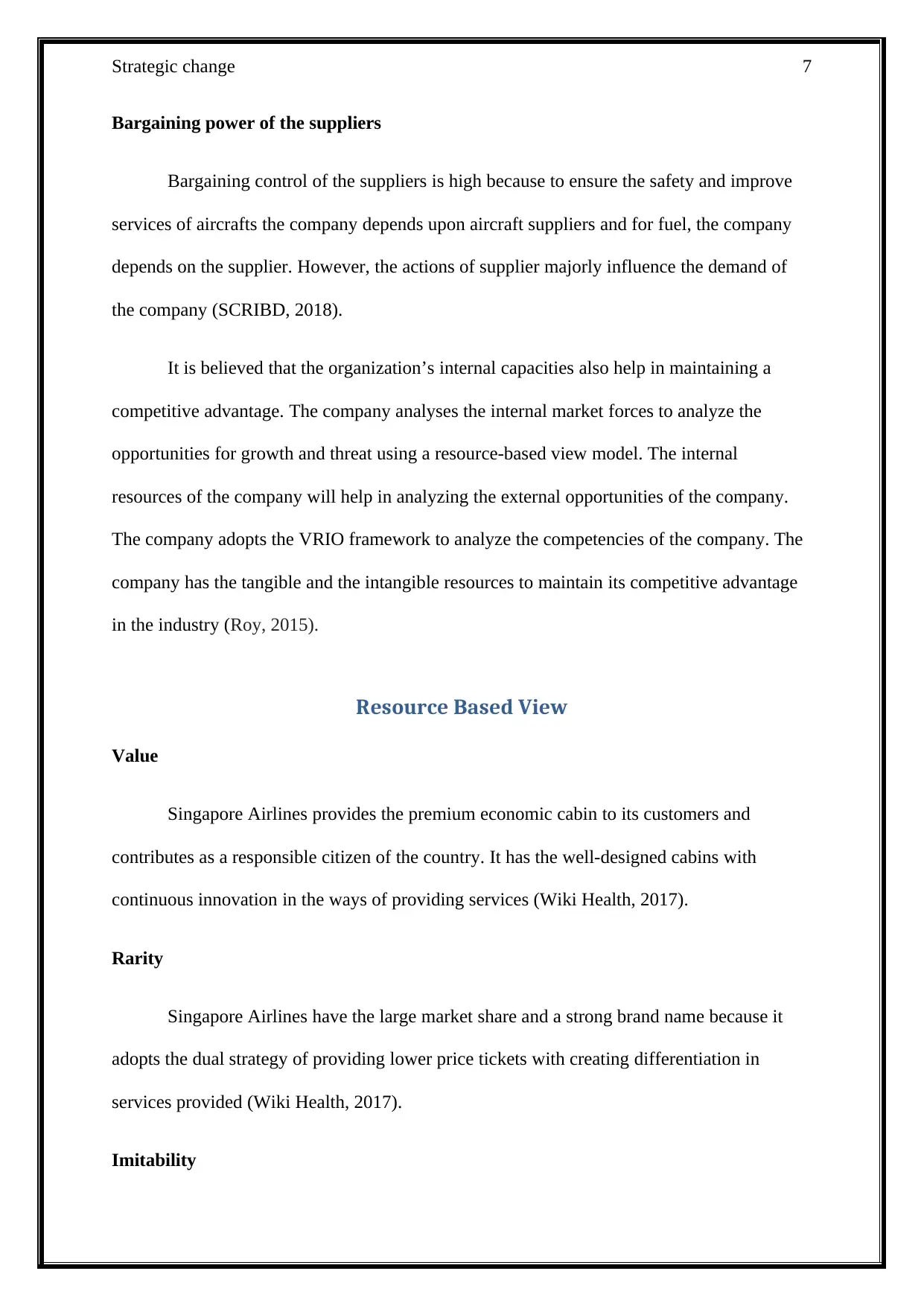
Strategic change 7
Bargaining power of the suppliers
Bargaining control of the suppliers is high because to ensure the safety and improve
services of aircrafts the company depends upon aircraft suppliers and for fuel, the company
depends on the supplier. However, the actions of supplier majorly influence the demand of
the company (SCRIBD, 2018).
It is believed that the organization’s internal capacities also help in maintaining a
competitive advantage. The company analyses the internal market forces to analyze the
opportunities for growth and threat using a resource-based view model. The internal
resources of the company will help in analyzing the external opportunities of the company.
The company adopts the VRIO framework to analyze the competencies of the company. The
company has the tangible and the intangible resources to maintain its competitive advantage
in the industry (Roy, 2015).
Resource Based View
Value
Singapore Airlines provides the premium economic cabin to its customers and
contributes as a responsible citizen of the country. It has the well-designed cabins with
continuous innovation in the ways of providing services (Wiki Health, 2017).
Rarity
Singapore Airlines have the large market share and a strong brand name because it
adopts the dual strategy of providing lower price tickets with creating differentiation in
services provided (Wiki Health, 2017).
Imitability
Bargaining power of the suppliers
Bargaining control of the suppliers is high because to ensure the safety and improve
services of aircrafts the company depends upon aircraft suppliers and for fuel, the company
depends on the supplier. However, the actions of supplier majorly influence the demand of
the company (SCRIBD, 2018).
It is believed that the organization’s internal capacities also help in maintaining a
competitive advantage. The company analyses the internal market forces to analyze the
opportunities for growth and threat using a resource-based view model. The internal
resources of the company will help in analyzing the external opportunities of the company.
The company adopts the VRIO framework to analyze the competencies of the company. The
company has the tangible and the intangible resources to maintain its competitive advantage
in the industry (Roy, 2015).
Resource Based View
Value
Singapore Airlines provides the premium economic cabin to its customers and
contributes as a responsible citizen of the country. It has the well-designed cabins with
continuous innovation in the ways of providing services (Wiki Health, 2017).
Rarity
Singapore Airlines have the large market share and a strong brand name because it
adopts the dual strategy of providing lower price tickets with creating differentiation in
services provided (Wiki Health, 2017).
Imitability
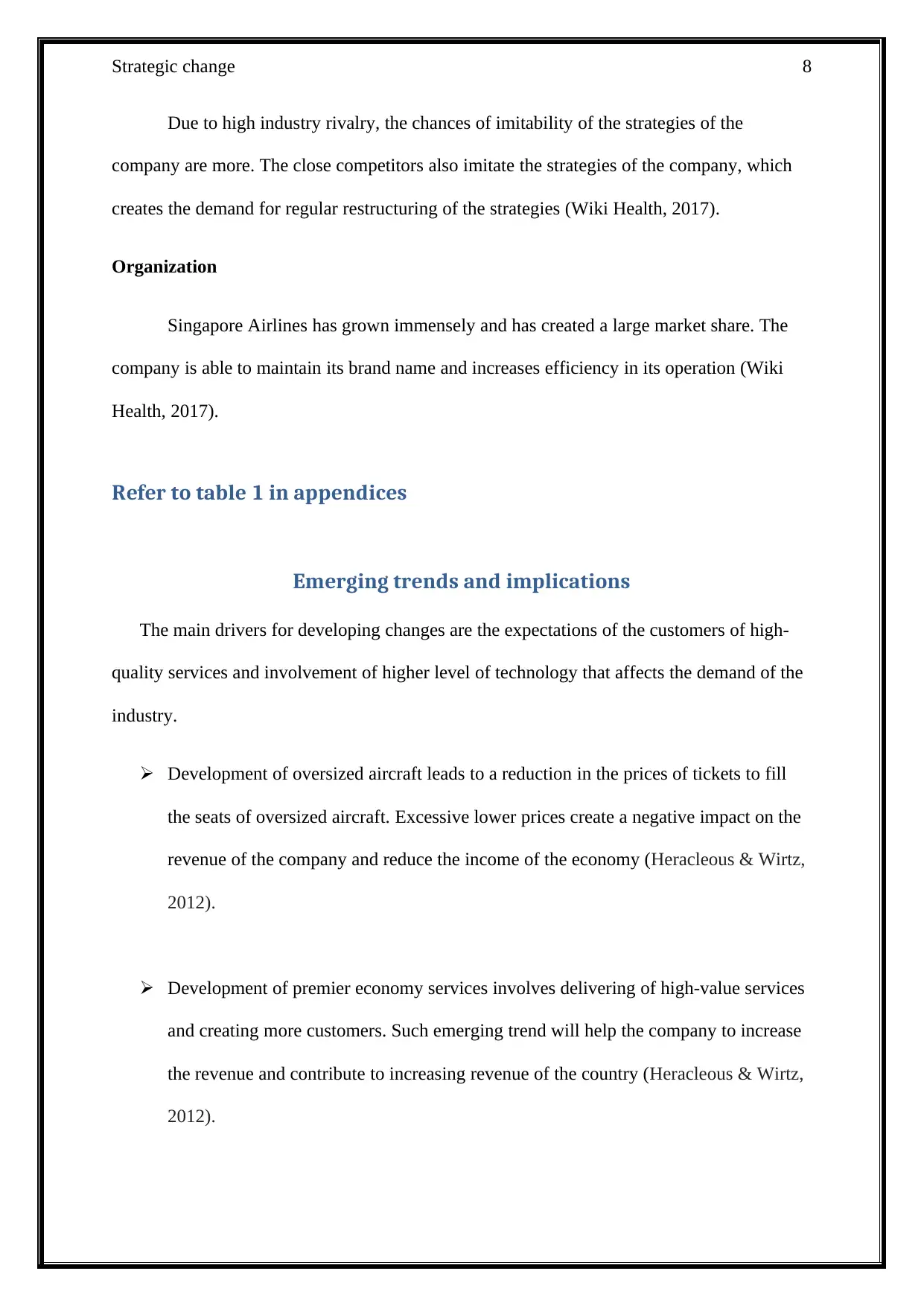
Strategic change 8
Due to high industry rivalry, the chances of imitability of the strategies of the
company are more. The close competitors also imitate the strategies of the company, which
creates the demand for regular restructuring of the strategies (Wiki Health, 2017).
Organization
Singapore Airlines has grown immensely and has created a large market share. The
company is able to maintain its brand name and increases efficiency in its operation (Wiki
Health, 2017).
Refer to table 1 in appendices
Emerging trends and implications
The main drivers for developing changes are the expectations of the customers of high-
quality services and involvement of higher level of technology that affects the demand of the
industry.
Development of oversized aircraft leads to a reduction in the prices of tickets to fill
the seats of oversized aircraft. Excessive lower prices create a negative impact on the
revenue of the company and reduce the income of the economy (Heracleous & Wirtz,
2012).
Development of premier economy services involves delivering of high-value services
and creating more customers. Such emerging trend will help the company to increase
the revenue and contribute to increasing revenue of the country (Heracleous & Wirtz,
2012).
Due to high industry rivalry, the chances of imitability of the strategies of the
company are more. The close competitors also imitate the strategies of the company, which
creates the demand for regular restructuring of the strategies (Wiki Health, 2017).
Organization
Singapore Airlines has grown immensely and has created a large market share. The
company is able to maintain its brand name and increases efficiency in its operation (Wiki
Health, 2017).
Refer to table 1 in appendices
Emerging trends and implications
The main drivers for developing changes are the expectations of the customers of high-
quality services and involvement of higher level of technology that affects the demand of the
industry.
Development of oversized aircraft leads to a reduction in the prices of tickets to fill
the seats of oversized aircraft. Excessive lower prices create a negative impact on the
revenue of the company and reduce the income of the economy (Heracleous & Wirtz,
2012).
Development of premier economy services involves delivering of high-value services
and creating more customers. Such emerging trend will help the company to increase
the revenue and contribute to increasing revenue of the country (Heracleous & Wirtz,
2012).
⊘ This is a preview!⊘
Do you want full access?
Subscribe today to unlock all pages.

Trusted by 1+ million students worldwide
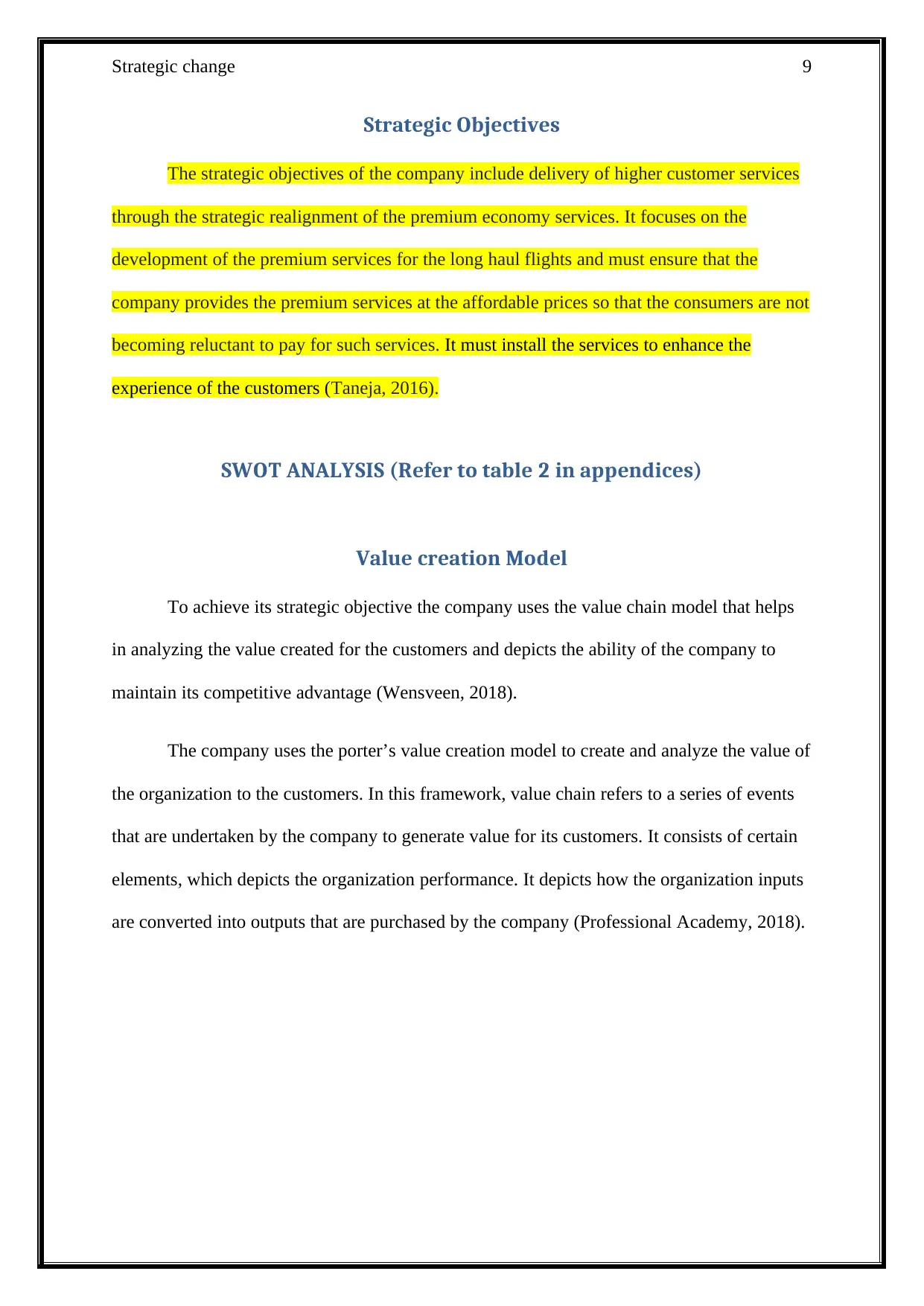
Strategic change 9
Strategic Objectives
The strategic objectives of the company include delivery of higher customer services
through the strategic realignment of the premium economy services. It focuses on the
development of the premium services for the long haul flights and must ensure that the
company provides the premium services at the affordable prices so that the consumers are not
becoming reluctant to pay for such services. It must install the services to enhance the
experience of the customers (Taneja, 2016).
SWOT ANALYSIS (Refer to table 2 in appendices)
Value creation Model
To achieve its strategic objective the company uses the value chain model that helps
in analyzing the value created for the customers and depicts the ability of the company to
maintain its competitive advantage (Wensveen, 2018).
The company uses the porter’s value creation model to create and analyze the value of
the organization to the customers. In this framework, value chain refers to a series of events
that are undertaken by the company to generate value for its customers. It consists of certain
elements, which depicts the organization performance. It depicts how the organization inputs
are converted into outputs that are purchased by the company (Professional Academy, 2018).
Strategic Objectives
The strategic objectives of the company include delivery of higher customer services
through the strategic realignment of the premium economy services. It focuses on the
development of the premium services for the long haul flights and must ensure that the
company provides the premium services at the affordable prices so that the consumers are not
becoming reluctant to pay for such services. It must install the services to enhance the
experience of the customers (Taneja, 2016).
SWOT ANALYSIS (Refer to table 2 in appendices)
Value creation Model
To achieve its strategic objective the company uses the value chain model that helps
in analyzing the value created for the customers and depicts the ability of the company to
maintain its competitive advantage (Wensveen, 2018).
The company uses the porter’s value creation model to create and analyze the value of
the organization to the customers. In this framework, value chain refers to a series of events
that are undertaken by the company to generate value for its customers. It consists of certain
elements, which depicts the organization performance. It depicts how the organization inputs
are converted into outputs that are purchased by the company (Professional Academy, 2018).
Paraphrase This Document
Need a fresh take? Get an instant paraphrase of this document with our AI Paraphraser
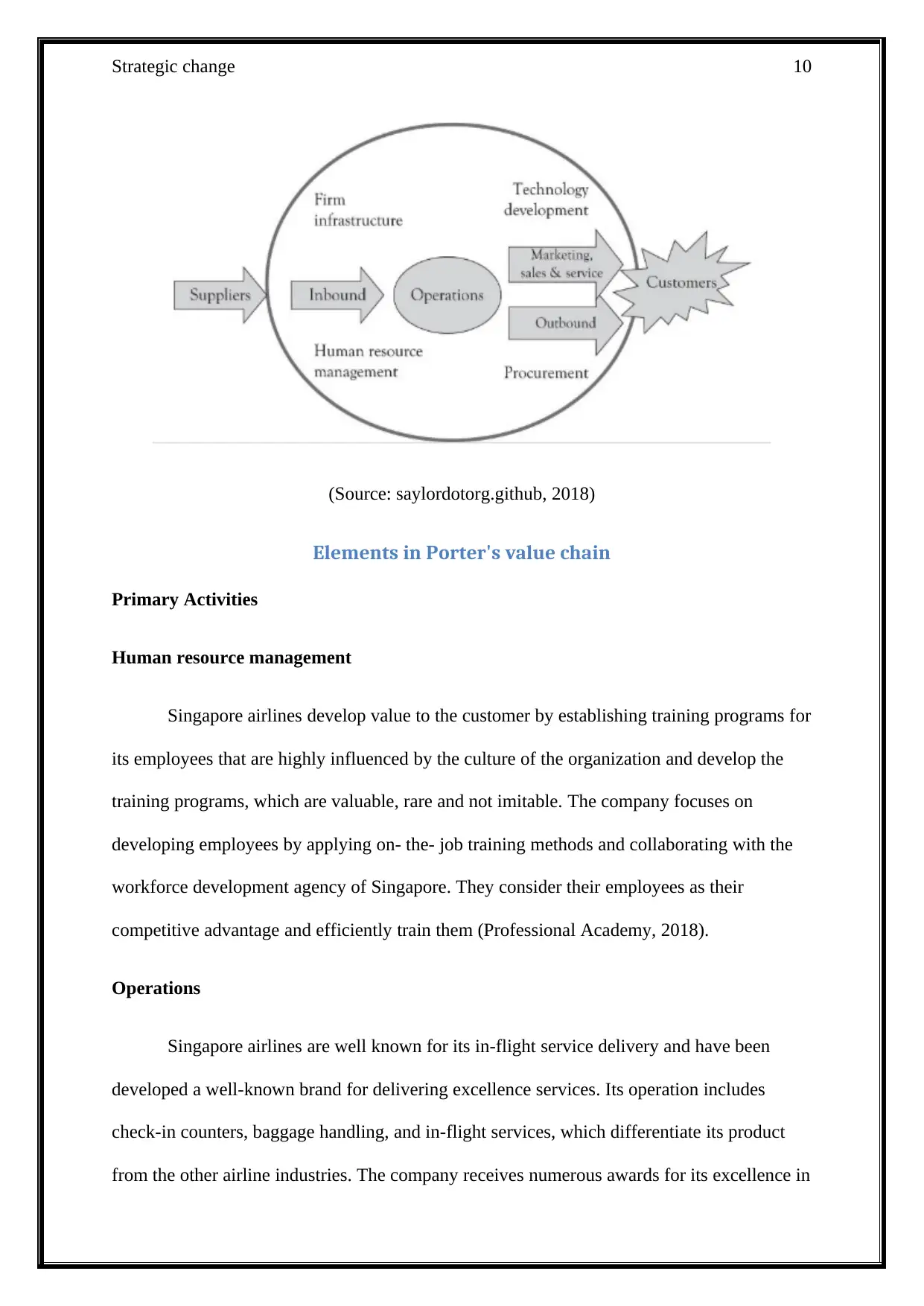
Strategic change 10
(Source: saylordotorg.github, 2018)
Elements in Porter's value chain
Primary Activities
Human resource management
Singapore airlines develop value to the customer by establishing training programs for
its employees that are highly influenced by the culture of the organization and develop the
training programs, which are valuable, rare and not imitable. The company focuses on
developing employees by applying on- the- job training methods and collaborating with the
workforce development agency of Singapore. They consider their employees as their
competitive advantage and efficiently train them (Professional Academy, 2018).
Operations
Singapore airlines are well known for its in-flight service delivery and have been
developed a well-known brand for delivering excellence services. Its operation includes
check-in counters, baggage handling, and in-flight services, which differentiate its product
from the other airline industries. The company receives numerous awards for its excellence in
(Source: saylordotorg.github, 2018)
Elements in Porter's value chain
Primary Activities
Human resource management
Singapore airlines develop value to the customer by establishing training programs for
its employees that are highly influenced by the culture of the organization and develop the
training programs, which are valuable, rare and not imitable. The company focuses on
developing employees by applying on- the- job training methods and collaborating with the
workforce development agency of Singapore. They consider their employees as their
competitive advantage and efficiently train them (Professional Academy, 2018).
Operations
Singapore airlines are well known for its in-flight service delivery and have been
developed a well-known brand for delivering excellence services. Its operation includes
check-in counters, baggage handling, and in-flight services, which differentiate its product
from the other airline industries. The company receives numerous awards for its excellence in
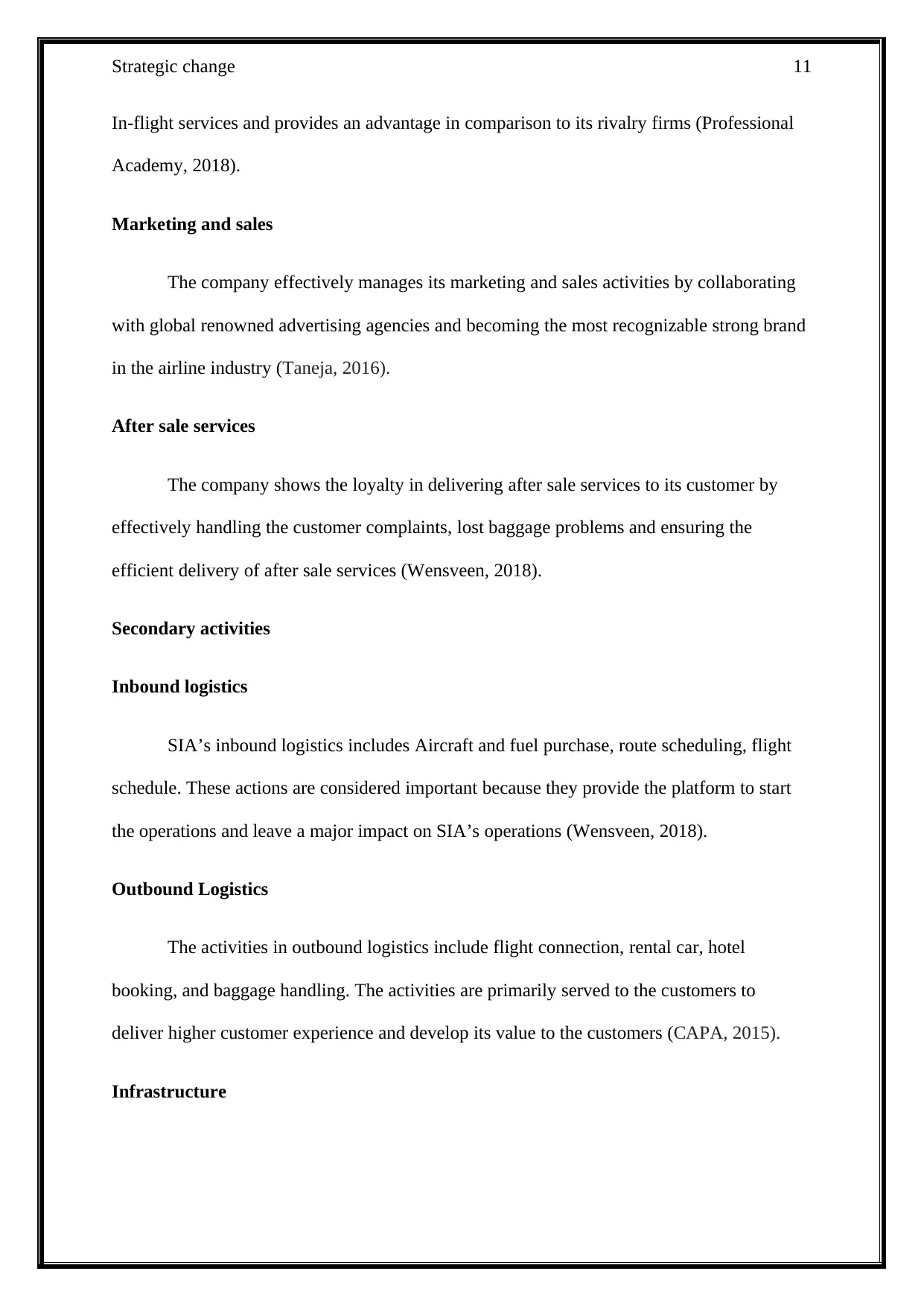
Strategic change 11
In-flight services and provides an advantage in comparison to its rivalry firms (Professional
Academy, 2018).
Marketing and sales
The company effectively manages its marketing and sales activities by collaborating
with global renowned advertising agencies and becoming the most recognizable strong brand
in the airline industry (Taneja, 2016).
After sale services
The company shows the loyalty in delivering after sale services to its customer by
effectively handling the customer complaints, lost baggage problems and ensuring the
efficient delivery of after sale services (Wensveen, 2018).
Secondary activities
Inbound logistics
SIA’s inbound logistics includes Aircraft and fuel purchase, route scheduling, flight
schedule. These actions are considered important because they provide the platform to start
the operations and leave a major impact on SIA’s operations (Wensveen, 2018).
Outbound Logistics
The activities in outbound logistics include flight connection, rental car, hotel
booking, and baggage handling. The activities are primarily served to the customers to
deliver higher customer experience and develop its value to the customers (CAPA, 2015).
Infrastructure
In-flight services and provides an advantage in comparison to its rivalry firms (Professional
Academy, 2018).
Marketing and sales
The company effectively manages its marketing and sales activities by collaborating
with global renowned advertising agencies and becoming the most recognizable strong brand
in the airline industry (Taneja, 2016).
After sale services
The company shows the loyalty in delivering after sale services to its customer by
effectively handling the customer complaints, lost baggage problems and ensuring the
efficient delivery of after sale services (Wensveen, 2018).
Secondary activities
Inbound logistics
SIA’s inbound logistics includes Aircraft and fuel purchase, route scheduling, flight
schedule. These actions are considered important because they provide the platform to start
the operations and leave a major impact on SIA’s operations (Wensveen, 2018).
Outbound Logistics
The activities in outbound logistics include flight connection, rental car, hotel
booking, and baggage handling. The activities are primarily served to the customers to
deliver higher customer experience and develop its value to the customers (CAPA, 2015).
Infrastructure
⊘ This is a preview!⊘
Do you want full access?
Subscribe today to unlock all pages.

Trusted by 1+ million students worldwide
1 out of 26
Related Documents
Your All-in-One AI-Powered Toolkit for Academic Success.
+13062052269
info@desklib.com
Available 24*7 on WhatsApp / Email
![[object Object]](/_next/static/media/star-bottom.7253800d.svg)
Unlock your academic potential
Copyright © 2020–2025 A2Z Services. All Rights Reserved. Developed and managed by ZUCOL.





